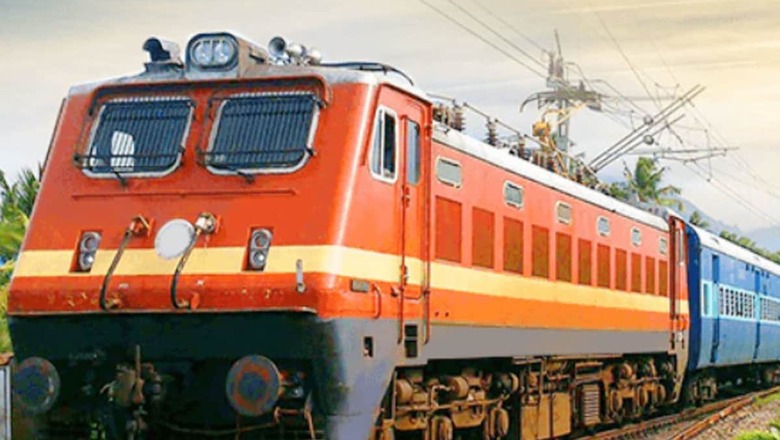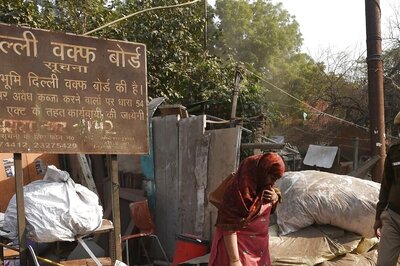
views
The Indian Railways, which manages the fourth largest national railway system in the world by size, with a total route length of nearly 69,000 km, is pushing for some serious makeovers. The move is positive, and will invariably help millions of commuters.
Let’s start counting. The first plan is big. The Railways wants to save 200,000 litres of diesel per day by electrifying all pit lines on its network. The idea is to replace fossil fuels with grid electrification. Pit lines are the spaces where train compartments are cleaned and maintained for the next journey. The Railways will substitute fossil fuels with grid electrification at all 411 maintenance pits by December 2023. The electrification of 302 pits has been completed. This is a very significant move.
Around 184,000 litres of diesel was being used on maintenance of Linke Hofmann Busch (LHB) rakes at pit lines every day. And because of the absence of electric lines at pit lines, these coaches required diesel generators to remain running when electrical faults were being corrected. The Railways have sanctioned the setting up of 750 V of power supply through grids across all LHB maintenance pits to reduce the use of diesel. The IR wanted to achieve net zero carbon emissions by 2030.
It has electrified 52,508 RKM out of a total BG network of 65,141 RKM (80.61 per cent). With 100 per cent electrification, the electricity demand will go up to about 72 BUs by 2029-30 from 21 BUs in 2019-20. The electrification of pit lines will reduce costs by 70-80 per cent compared to existing head-on-generation (HOG-compliant) LHB rakes. The move is expected to bring in over Rs 450 crore annually. The diesel-powered rakes were estimated to have an annual recurring expenditure of over Rs 668 crore, which was seen growing at 20 per cent due to inflation in diesel prices and a rise in LHB fleet size, making the shift necessary.
While this looks good on paper, it is a very expensive proposition in reality. The Railways want to sell extra land to raise cash, which could make it India’s biggest real estate operator. It has plans to develop around 43,000 hectares of surplus land, some of it in the toniest parts of cities. The Rail Land Development Authority (RLDA) is betting big on interest coming back into the real estate sector to commercially develop railway land parcels, and in the process, more than tripled the award of its lease contracts to over Rs 10,000 crore in FY24. The game plan is to develop land commercially so that it earns value for Railways. This, in short, is a monetisation exercise to generate revenues through the leasing of surplus railway land, and also leasing of built-up assets.
The IR also has an ambitious plan to achieve net-zero carbon emissions by 2030 and increase network capacity. It will be primarily through sourcing its energy requirements from renewable energy sources and construction of dedicated freight corridors, green certification of railway establishments etc. This is a big task logistically and administratively. By 2029-30, the expected requirement of installation of renewable capacity would be about 30 GW. Indian Railways has installed 142 MW of solar rooftop capacity and 103.4 MW of wind energy.
This is not all. The Railways is now seriously thinking about averting accidents. India’s train collisions have always been the deadliest, and each time the blame has come on people manning its notoriously dangerous rail network. The latest accident happened in June 2023, leaving at least 288 dead and hundreds injured. It was one of the worst rail accidents in the country’s history. Every time accidents have happened, carriages have flipped over entirely and rescue workers scrambled to pull out survivors trapped in the mangled wreckage. In the past two decades alone, the country has had at least 13 railway accidents.
But now, a small team of engineers are shaping the Kavach programme to pull Indian Railways out of this humongous crisis. This is an indigenously developed Automatic Train Protection (ATP) system which aids the loco pilot in trains running within specified speed limits by automatic application of brakes in case the loco pilot fails and also helps the train run safely during inclement weather.
The first field trials on the passenger trains were started in February 2016. Based on the experience gained and the Independent Safety Assessment of the system by a third party (Independent Safety Assessor: ISA), the IR approved three firms as OEMs. Made in India, Kavach was adopted as a National ATP of India in July 2020 under the Atmanirbhar Bharat mission by Prime Minister Narendra Modi.
It has so far been deployed on 1465 Route km and 121 locomotives in Telangana (684 Rkm), Andhra Pradesh (66 Rkm), Karnataka (117 Rkm) & Maharashtra (598 Rkm). Tenders have been awarded for Delhi-Mumbai and Delhi-Howrah corridors (approximately 3000 Route km) and work is in progress on these routes in West Bengal, Jharkhand, Bihar, Uttar Pradesh, Delhi, Haryana, Rajasthan, Madhya Pradesh, Gujarat and Maharashtra.
Kavach will be rolled out across all board gauge lines of Indian Railways by 2030 and is meant to provide protection by preventing trains from passing the signal at danger (red) and avoiding collision. It activates the train braking system automatically if the driver fails to control the train as per the speed restrictions. In addition, it prevents collisions between two Locomotives equipped with a functional system. It is one of the cheapest safety technologies with an error probability of 1 in 10,000 years. Additionally, it opens avenues of export of this indigenous technology for Railways. This will change the lives of millions of commuters.
This system is fail-safe so even if it fails, it will stop the train, but any false system alarm will also force it to stop the train. Moreover, this system needs to be enabled in locos, on railway stations as well and on track to give full desired protection.
Indian Railways has developed Kavach to enhance the safety of running trains. It has been developed completely indigenously by the Indian Railways Research and Development Organisation in association with three Indian vendors and it has been adopted as our National Automatic Train Protection (ATP) System. Kavach will not only aid loco pilots to avoid Signal Passing At Danger (SPAD) and overspeeding but also help in train running during inclement weather such as dense fog. It is an indigenously developed highly technology-intensive system, which comes with safety certification of the highest order. There are chances that the system will roll out in Africa, Sri Lanka and Bangladesh. Indian Railways is actually on a roll.
The author is Rajya Sabha MP, Chairman of the Parliamentary Standing Committee on Transport, Tourism & Culture. Views expressed in the above piece are personal and solely that of the author. They do not necessarily reflect News18’s views.




















Comments
0 comment